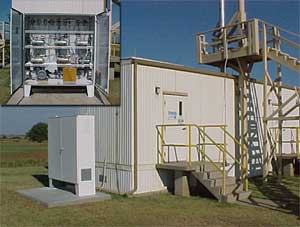Representing the first of several planned improvements to the Aerosol Observing System (AOS) at the SGP site, the ARM Climate Research Facility operations staff completed installing a new pump shelter for the system in late September, followed by relocation of the pumps and connection of the electrical hookups in October. Though the enclosure was designed primarily to move the nine vacuum pumps out of the existing AOS trailer—thereby reducing the potential for damage to the AOS instruments from heat generated by the pumps—noise reduction in the AOS trailer was another desired outcome. Anticipated instrument additions were also considered in designing the new enclosure.

The completed cabinet assembly was received from the vendor in late September and attached by operations staff to a concrete foundation next to the AOS. About a month later, the pumps were moved into the shelter and aerosol sample lines were extended from the existing pump locations and routed to the new shelter through a tubing chase (conduit). The pumps, exhaust lines, and associated electrical outlets were all color-coded to aid in identifying related pieces of equipment.
The AOS represents the primary platform for in-situ aerosol measurements at surface level. Instruments contained in the AOS include two nephelometers, and one each of the following: light absorption photometer, condensation nuclei counter, optical particle counter, and ozone monitor. Combined, these instruments measure the optical properties of ambient aerosol particles to help scientists better understand how the particles interact with solar radiation and influence the earth’s radiation balance and climate system.
In addition to reducing the heat and noise levels in the AOS trailer, relocation of the vacuum pumps frees up room for the addition of a Tandem Differential Mobility Analyzer. This instrument, which measures the size distribution, refractive index and moisture absorption potential of aerosols, will be built by Texas A&M University and is scheduled for deployment in the AOS in 2005. Additional AOS upgrades to occur in 2005 include expanded measurements for the particle soot absorption photometer instruments, which currently provide measurements of absorption at 565 nm. These instruments will be upgraded to add measurements at 450 nm and 700 nm to complement nephelometer measurements of total scatter and hemispheric backscatter at 450 nm, 550 nm, and 700 nm.

